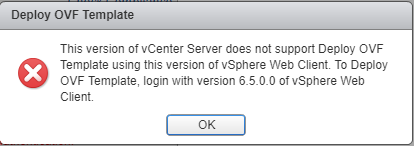

Now that the C# client has been replaced by the vSphere Web Client and the HTML5 VMware Host Client in vSphere 6.5, these OVFs should no longer be used. These OVFs were previously used for deploying vSphere Replication in SRM environments using the C# vSphere Client. VSphere_Replication_SRM and vSphere_Replication_Server_SRM This OVF should not be deployed for on-premises use cases. VMware vCloud Air and vCAN providers enable vSphere Replication on the provider side using this appliance. This is in addition to the VRMS for a total of 10 VR appliances per vCenter Server environment. The maximum supported number of VRS appliances that can be deployed in a single vCenter Server environment is nine.

VRS appliances are used to scale up the number of VMs that can be replicated in an environment. It simply receives replicated data from the source host(s) and it is managed by the VRMS. A VRS appliance does not have the VR management capabilities enabled. The “AddOn” appliance is commonly called a vSphere Replication Server (VRS). This OVF is used to deploy additional VR virtual appliances after a VRMS has been deployed. If a larger number of VMs will be replicated, the vSphere_Replication_AddOn OVF (below) is used to deploy additional appliances. In many cases, this is the only appliance you need to deploy – just one – nice and simple. Only one VRMS appliance should be deployed in a vCenter Server environment. Stand-alone replication (without SRM and/or vCloud Air)Īt a minimum, you must have a VRMS appliance in each vCenter Server environment to utilize vSphere Replication. Migration and disaster recovery services enabled by VMware vCloud Air and vCloud Air Network (vCAN) providers. Replication with VMware Site Recovery Manager (SRM) The VRMS appliance is deployed for the following use case: The appliance is usually referred to as a vSphere Replication Management Server (VRMS). This appliance receives replication from the source host(s) and it has the VR management services enabled. The vSphere_Replication OVF is the first virtual appliance that is deployed in an on-premises environment. Now let’s proceed with explaining the types of OVFs found on the VR ISO. Note that there are two VMDK files – support and system – both must be included when deploying a VR appliance.Īfter clicking the browse button, select the necessary files…įor detailed steps on deploying vSphere Replication 6.5, see the vSphere Replication 6.5 Documentation.

These include the CERT, MF, OVF, and VMDK files. When deploying an OVF using the vSphere Web Client, you must select all of the necessary files that go along with the OVF.
#Depoy ovf vmware 6.5 iso#
While more general information on VR can be found here, this article focuses on the various OVFs that are found on the VR ISO and what the use cases are for each. VR is deployed as a virtual appliance using an Open Virtualization Format (OVF) specification found on the VR ISO that is downloaded from. VR is a host-based virtual machine (VM) replication solution that works with nearly any storage type supported by vSphere. VMware vSphere Replication 6.5 is the latest version of vSphere Replication (VR) released with vSphere 6.5, vCenter Server 6.5, and Site Recovery Manager (SRM) 6.5.


 0 kommentar(er)
0 kommentar(er)
